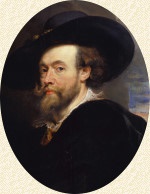|
Peter Paul Rubens was one of the most important artists of the Flemish Baroque. He was both, a painter and a diplomat of the Spanish Habsburg crown.
Born: 28 June 1577 in Siegen, Nassau-Dillenburg, Holy Roman Empire (today Germany)
Died: 30 May 1640 in Antwerp, Spanish Netherlands (today Belgium)
The painter Peter Paul Rubens, who stems from the educated middle class, is taught by three painters, one of whom is Otto van Veen who may have been the most influential one. At least the early work of Peter Paul Rubens still shows some hints to him. As early as in the year 1600, he travels to Italy and works as a court painter in Mantua. The portrait “Die Geissblattlaube”, which is produced shortly after his return to Antwerp, shows the painter with his first wife, Isabella Brant. Already in 1608, Peter Paul Rubens is well-known and receives numerous orders: he works as court painter to the archduke couple in Brussels, as well as for noble and ecclesiastical clients like the Jesuit Order, for whose Antwerp church, he designs 39 ceiling paintings. Starting from 1620, Peter Paul Rubens has found his very own, very picturesque, pathetically moving style. He develops a great variety of themes: hunting scenes, mythological and historical paintings as well as portraits and religious altar panels. From 1622, the internationally sought-after artist travels to the courts of Spain, England and France where he is highly esteemed and, in some cases, knighted, also from a diplomatic point of view. In the later works, his style slightly changes again: he becomes more colorful and less contrasting in the lighting as well as more characteristic in the portrait painting: the portrait “Helene Fourment in the Wedding Dress” from 1630 shows Rubens’ second wife, dressed in ostentatious dresses, which may also be a hint to the prosperity of her husband.
|
 |
|
|